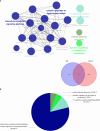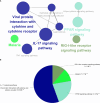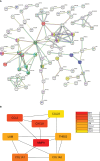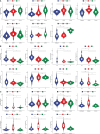Exploration of the core pathway of inflammatory bowel disease complicated with metabolic fatty liver and two-sample Mendelian randomization study of the causal relationships behind the disease
- PMID: 38698841
- PMCID: PMC11063260
- DOI: 10.3389/fimmu.2024.1375654
Exploration of the core pathway of inflammatory bowel disease complicated with metabolic fatty liver and two-sample Mendelian randomization study of the causal relationships behind the disease
Abstract
Background: Inflammatory bowel disease (IBD) is often associated with complex extraintestinal manifestations. The incidence of nonalcoholic fatty liver disease (NAFLD) in IBD populations is increasing yearly. However, the mechanism of interaction between NAFLD and IBD is not clear. Consequently, this study aimed to explore the common genetic characteristics of IBD and NAFLD and identify potential therapeutic targets.
Materials and methods: Gene chip datasets for IBD and NAFLD were obtained from the Gene Expression Omnibus (GEO) database. Weighted gene co-expression network analysis (WGCNA) was performed to identify modules in those datasets related to IBD and NAFLD. ClueGO was used for biological analysis of the shared genes between IBD and NAFLD. Based on the Human MicroRNA Disease Database (HMDD), microRNAs (miRNAs) common to NAFLD and IBD were obtained. Potential target genes for the miRNAs were predicted using the miRTarbase, miRDB, and TargetScan databases. Two-sample Mendelian randomization (MR) and two-way MR were used to explore the causal relationship between Interleukin-17 (IL-17) and the risk of IBD and NAFLD using data from GWAS retrieved from an open database.
Results: Through WGCNA, gene modules of interest were identified. GO enrichment analysis using ClueGO suggested that the abnormal secretion of chemokines may be a common pathophysiological feature of IBD and NAFLD, and that the IL-17-related pathway may be a common key pathway for the pathological changes that occur in IBD and NAFLD. The core differentially expressed genes (DEGs) in IBD and NAFLD were identified and included COL1A1, LUM, CCL22, CCL2, THBS2, COL1A2, MMP9, and CXCL8. Another cohort was used for validation. Finally, analysis of the miRNAs identified potential therapeutic targets. The MR results suggested that although there was no causal relationship between IBD and NAFLD, there were causal relationships between IL-17 and IBD and NAFLD.
Conclusion: We established a comorbid model to explain the potential mechanism of IBD with NAFLD and identified the chemokine-related pathway mediated by cytokine IL-17 as the core pathway in IBD with NAFLD, in which miRNA also plays a role and thus provides potential therapeutic targets.
Keywords: IL-17; chemokine; inflammatory bowel disease; nonalcoholic fatty liver disease; therapy.
Copyright © 2024 Wei and Wang.
Conflict of interest statement
The authors declare that the research was conducted in the absence of any commercial or financial relationships that could be construed as a potential conflict of interest.
Figures













Similar articles
-
Non-alcoholic fatty liver disease and heart failure: A comprehensive bioinformatics and Mendelian randomization analysis.ESC Heart Fail. 2024 Dec;11(6):4185-4200. doi: 10.1002/ehf2.15019. Epub 2024 Aug 14. ESC Heart Fail. 2024. PMID: 39143741 Free PMC article.
-
Exploration of Shared Gene Signatures and Molecular Mechanisms Between Periodontitis and Nonalcoholic Fatty Liver Disease.Front Genet. 2022 Jun 28;13:939751. doi: 10.3389/fgene.2022.939751. eCollection 2022. Front Genet. 2022. PMID: 35836570 Free PMC article.
-
Type 1 diabetes mellitus and non-alcoholic fatty liver disease: a two-sample Mendelian randomization study.Front Endocrinol (Lausanne). 2024 Apr 12;15:1315046. doi: 10.3389/fendo.2024.1315046. eCollection 2024. Front Endocrinol (Lausanne). 2024. PMID: 38681765 Free PMC article.
-
Multifaceted pathogenesis of liver steatosis in inflammatory bowel disease: a systematic review.Eur Rev Med Pharmacol Sci. 2021 Sep;25(18):5818-5825. doi: 10.26355/eurrev_202109_26800. Eur Rev Med Pharmacol Sci. 2021. PMID: 34604973
-
Homocysteine, folate, and nonalcoholic fatty liver disease: a systematic review with meta-analysis and Mendelian randomization investigation.Am J Clin Nutr. 2022 Dec 19;116(6):1595-1609. doi: 10.1093/ajcn/nqac285. Am J Clin Nutr. 2022. PMID: 36205540
Cited by
-
Integration of single-cell sequencing and mendelian randomization reveals novel causal pathways between monocytes and hepatocellular carcinoma.Discov Oncol. 2025 Apr 24;16(1):604. doi: 10.1007/s12672-025-02357-x. Discov Oncol. 2025. PMID: 40272662 Free PMC article.
-
Identification and verification of oxidative stress-related genes in the diagnosis of osteoporosis.Sci Rep. 2025 Jul 2;15(1):23222. doi: 10.1038/s41598-025-06118-2. Sci Rep. 2025. PMID: 40603950 Free PMC article.
-
The use of circulating miRNAs for the diagnosis, prognosis, and personalized treatment of MASLD.J Physiol Biochem. 2025 Aug;81(3):589-609. doi: 10.1007/s13105-025-01110-w. Epub 2025 Jul 16. J Physiol Biochem. 2025. PMID: 40668532 Review.
References
Publication types
MeSH terms
Substances
LinkOut - more resources
Full Text Sources
Medical
Miscellaneous

